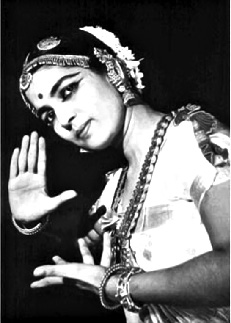

Socio-cultural reforms in India have challenged, in principle and practice, some age-old prejudices that had flourished unfettered in the garb of tradition. Reformers have performed the arduous task of inculcating momentous changes through free thought, expression, belief, speech and worship. By the turn of the twentieth century, India had embraced a neo-cultural renaissance that Europe had experienced a few centuries earlier. While Dance in India has its unique technique, narrative, presentation and divinity, it can be especially enhanced by a woman’s beauty, love and dignity. A rare fusion of a femme par excellence, an extraordinary Danseuse and a reformist therein, standing strikingly tall in the dancing pantheon, is Rukmini Devi Arundale, the doyen of Bharathanatyam and the founder of the Kalakshetra School, Chennai - an Academy of cultural excellence that is striving to preserve Indian culture. Bharathanatyam is one of the foremost Classical Dances of India. Believed to have originated in Thanjavur in Tamil Nadu, the origin of Bharathanatyam also traces itself to a Dance form called ‘Sadir’. It was initially referred to as Dasinatyam (Dance performed by ‘dasis’ or servants), as it was performed by Devadasis - who were girls ‘dedicated’ to God and thereafter lived their lives in temples. Later, due to the lack of patronage to Dance from the weakened kingdoms, there was widespread exploitation of the Devadasis, and often they were forced to resort to prostitution to sustain their families. However, since the twentieth century, Bharathanatyam has occupied a pivotal place in our Dance culture, mainly due to the efforts of a special few. The legendary Balasaraswati, born in a traditional Dance performing family, worked extensively to help restore the dignity of the Devadasis; E. Krishna Iyer is credited for modifying the ‘Sadir’; and Rukmini Devi Arundale provided the watershed in the Dance form’s evolution through the next hundred years.
Rukmini Devi was born in 1904 to an educated theosophist, who was influenced by Annie Besant’s monotheistic ideas and the unity of religious thought, in a traditional Brahmin family in Madura (Madurai) in erstwhile Madras Presidency. This was a time when it was unfathomable for women born in ‘respectable’ families to even contemplate Dancing. However, due to her theosophical upbringing, Rukmini was introduced to the reformist ideas of Besant and a British theosophist, George Arundale, whom she married at the age of sixteen - amidst jeers from the traditional Brahmin community of Madras (Chennai). As she extensively travelled with George, a chance meeting aboard a ship with the famous Russian ballerina, Anna Pavalova, transformed Rukmini. She learnt ballet from one of Pavalova’s students and also then decided that it was time to revive the Indian Arts. As she commenced with the resurrection of Bharathanatyam, which was then performed only in temples, she knew it was imperative to tackle the Devadasi issue. She approached a talented Nattuvanar (Choreographer-teacher), Meenakshi Sundaram Pillai, a Pandanallur exponent (a traditional Dance technique emphasising the concepts of ‘aduvu’ and ‘abhinaya’) and also Mylapore Gowri Amma and E. Krishna Iyer, to understand the subtle intricacies of the Dance form. Within three years Rukmini created a new style, which is today known as the Kalakshetra style. Rukmini also discovered that Bharathanatyam’s erotic element, or ‘Sringara’, needed to be transformed with Bhakti (devotion); she replaced the erotic chest and hip movements of the Dance, with more ‘appropriate’ ones. Rukmini encouraged the use of instruments like the violin and commissioned the designing of Dance jewellery inspired by temple sculptures. The Kalakshetra School was founded in 1936 with the active encouragement from her husband, George. The Institution’s name was suggested by a scholar, Subramania Shastri. Choreographing many Dance dramas from the Ramayana and other epics, notably the ‘Gita Govindam’ and the ‘Sita Swayamwaram’, Rukmini performed at the Theosophical Society, challenging the prejudiced, pessimistic and dismissive society of pre-independent India. Struck by Rukmini Devi’s talent and innovation, there was a gradual acceptance of her viewpoint. Within a span of a few years the results of the reform were visible; many young girls from traditional Brahmin families were initiated into Dance - widening its scope and enhancing its respectability.
Rukmini Devi’s work was rewarded and recognised the world over. She was the recipient of the Padma Bhushan, the Sangeet Natak Academi Award, and an Honorary doctorate from the Wayne State University, USA; she was also a nominated member of the Rajya Sabha. It is also believed that the Prime Minister of India, Morarji Desai, offered to forward her nomination for the post of the President of India - which she presumably declined politely. Even as she grew older, Rukmini Devi continued to nurture Kalakshetra. Bharathanatyam dancers flocked to her to gain knowledge, and her intense eye for detail left her admirers astounded. Her true calling was the revival of Bharathanatyam and the inclusion of purpose and penance into the Dance form. She breathed her last in 1986, aged 82 - ending an era of a unique contribution to Indian Classical Dance. Her charismatic personality still towers over an entire century of Classical Dance performers of other Dance forms as well. Kalakshetra has been declared an Institution of National importance and many leading performers of Bharathanatyam are today carrying forward Rukmini Devi’s ideals, teachings and innovative choreography.
The Writer is a renowned Kuchipudi Danseuse and Choreographer
Read More...